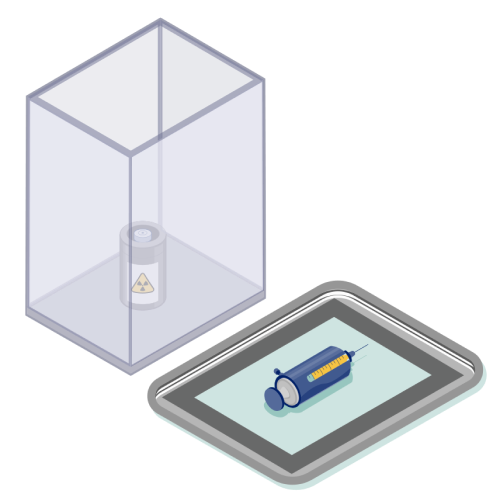
Providing and administering RLT
This section of the Novartis RLT Institute is designed to help health care professionals (HCPs) understand radiation safety procedures for providing and administering radioligand therapies (RLTs) manufactured by Novartis. It is based on guidelines from regulatory agencies, including the Nuclear Regulatory Commission (NRC), the Department of Transportation (DOT), and the United States Pharmacopeia (USP). Topics include safe transport, administration, and postadministration protocols to prepare the patient and room for subsequent use.
Receiving, handling, and storage
Safe handling
To minimize exposure to ionizing radiation, guidelines from the NRC emphasize the importance of understanding and managing risks for both the public and radiation workers:

Public (nonoccupational exposure in uncontrolled areas): This group includes visitors or employees not routinely working with radiation sources. Uncontrolled areas include offices, public hallways, or adjacent rooms. Radiation dose rates in uncontrolled areas should not exceed 1 mSv/year.1,2

Radiation workers (occupational exposure in controlled areas): This group includes employees or staff whose occupational radiation exposure is regularly monitored. For these workers, the radiation dose equivalent must be below 50 mSv/year.3
Handling Lutetium 177 (177Lu)
When handling 177Lu-based RLTs, as 177Lu emits beta particles (Eβ max = 497.8 keV (78.6 %), 384.9 keV (9.1 %), 176.5 keV (12.2 %) and 248.1 keV (0.05%)) and low-energy gamma rays (Eγ = 208.4 keV (11.0%), 112.9 keV (6.2%), 321.3 keV (0.22%), 249.7 keV (0.21%), 71.6 keV (0.15%) and 136.7 keV (0.05%)), safety measures following the ALARA (as low as reasonably achievable) principle are applied to minimize radiation exposure effectively.4-6

Shielding
Specialized acrylic shielding is recommended for high-energy beta particles. While most plastics can block beta radiation, acrylic offers a more reliable and consistent level of protection, making it the preferred choice for shielding. Lead or concrete shielding may be effective options to block low-energy gamma photons emitted by 177Lu.7,8
Depending on factors such as occupancy, floor plan, distance from the source, dose limit, and exposure rate, fixed shielding may not be required in treatment rooms specifically for 177Lu-based therapy.9 However, some sites may use shielded rooms originally designed for other applications, such as 131I therapy, PET, or other imaging.9,10
See more about facility shieldingTransporting within the RLT facility
When moving the dose throughout the facility, take precautions to minimize exposure and prevent spills. The dose should be transported in a radioactive material (RAM) shield, such as the shield provided upon dose delivery.10


Expert insight
For additional safety, stability, and containment, the dose can be transported within an additional shielded container on a stainless steel, non-fibrous cart lined with absorbent pads.7,11

See safety in action
The following video outlines the radiation safety procedures for RLT, covering the process from the initial receipt of RAMs at the facility to the postadministration handling and return of the residual radioactive material.
